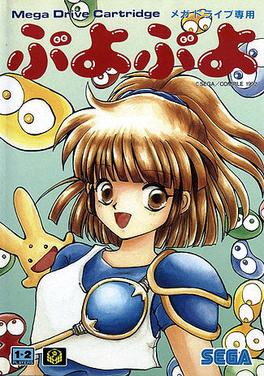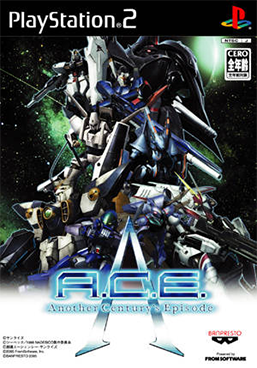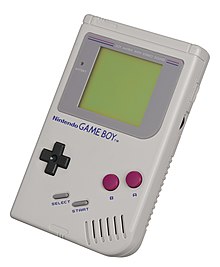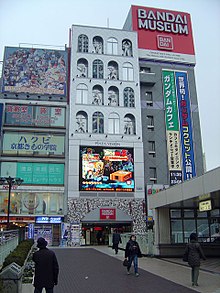
Bandai Co., Ltd. is a Japanese multinational toy manufacturer and distributor headquartered in Taitō, Tokyo. Its international branches, Bandai Namco Toys & Collectables America and Bandai UK, are respectively headquartered in Irvine, California, and Richmond, London. Since 2006, Bandai is the toy production division of Bandai Namco Holdings. Between 1981 and 2001, Bandai was a manufacturer of video game consoles.

Puyo Puyo (ぷよぷよ) is a puzzle video game released in 1991 by Compile for the MSX2. Since its creation, it uses characters from Madō Monogatari. It was created by Masamitsu "Moo" Niitani, the founder of Compile, who was inspired by certain elements from the Tetris and Dr. Mario series of games.

Namco Limited was a Japanese multinational video game and entertainment company, headquartered in Ōta, Tokyo. It held several international branches, including Namco America in Santa Clara, California, Namco Europe in London, Namco Taiwan in Kaohsiung, and Shanghai Namco in mainland China.

Bandai Visual Co., Ltd. was a Japanese anime, film production, and distribution company, established by Bandai and a subsidiary of Bandai Namco Holdings. They focused mainly in international distribution of anime properties in North America.

Sega Sammy Holdings Inc. is a Japanese global conglomerate formed from the merger of Sega and Sammy Corporation in 2004. Both companies are involved in the amusement industry.
Super Robot Wars, known in Japan as Super Robot Taisen, is a series of Japanese tactical role-playing video games produced by Bandai Namco Entertainment, formerly Banpresto. Starting out as a spinoff of the Compati Hero series, the main feature of the franchise is having a story that crosses over several popular mecha anime, manga and video games, allowing characters and mecha from different titles to team up or battle one another. The first game in the franchise was released for the Game Boy on April 20, 1991. Later spawning numerous games that were released on various consoles and handhelds. Due to the nature of crossover games and licensing involved, only a few games have been released outside Japan, and in English. The franchise celebrated its 25th anniversary in 2016, and its 30th anniversary in 2021.
Cyber Troopers Virtual-On is a series of video games created by Sega AM3. The series was created by Juro Watari. The original series was first published for arcades in January 1996. The game features fast, action-oriented gameplay requiring quick reflexes. It has seen five installments to date and has been ported to several video game consoles.

Another Century's Episode is a 2005 third-person shooter video game published by Banpresto in Japan for the PlayStation 2. The player controls a mech from one of nine different anime robot franchises to destroy opposing forces before they steal a prized energy source for devious purposes. The game is divided into several different missions, where players use their mech and arsenal of weapons to fulfill mission objectives, ranging from destroying enemy machines to protecting a specific target.

Bandai Namco Holdings Inc. is a Japanese entertainment holding company founded in 2005 by the merger of Namco and Bandai. The company specializes in toys, video games, arcades, anime, restaurants, and amusement parks.

Bandai Namco Entertainment Inc. is a Japanese multinational video game publisher owned by Bandai Namco Holdings. It was founded in 2006 as Namco Bandai Games Inc., following the 2005 merger of Namco and Bandai. Namco acquired Bandai's video game business division through a corporate split. In 2009, Bandai Namco Games absorbed Bandai Networks. It is headquartered in Minato, Tokyo.

Kidō Senshi Gundam: Senjō no Kizuna, is a Japanese arcade game set in the original Gundam universe. The game was created by Bandai Namco and Banpresto and was released late 2006. Play involves stepping into a P.O.D. and doing battle with other players across Japan.

M2 Co., Ltd. is a Japanese video game developer and publisher, best known for handling emulation of re-released games, such as some Sega Ages titles, Virtual Console titles for Nintendo systems, the 3D Classics series for the Nintendo 3DS and their ShotTriggers range of classic STG games. M2 has also created entirely new titles such as WiiWare games for Konami under the ReBirth moniker and more recently a new GG Aleste game. In addition, M2 currently holds the rights of Aleste series and all NEC Avenue and NEC Interchannel games on TurboGrafx-16 and variants, previously owned by Lightweight.

Sega Corporation is a Japanese multinational video game and entertainment company headquartered in Shinagawa, Tokyo. Its international branches, Sega of America and Sega Europe, are headquartered in Irvine, California, and London. Its division for the development of both arcade games and home video games, Sega Games, has existed in its current state since 2020; from 2015 to that point, the two had made up separate entities known as Sega Games and Sega Interactive Co., Ltd. Sega is a subsidiary of Sega Sammy Holdings. From 1983 until 2001, Sega had also developed video game consoles.

Bandai Namco Studios Inc. is a Japanese video game developer headquartered in Kōtō, Tokyo. Its offices in Malaysia and Singapore, Bandai Namco Studio Malaysia and Bandai Namco Studios Singapore, are based out of Selangor, Malaysia and Infinite Studios, Singapore respectively. Bandai Namco Studios is a subsidiary of Bandai Namco Entertainment, which itself is a subsidiary of Bandai Namco Holdings. The company works under its parent company as a keiretsu; Bandai Namco Studios creates video games for home consoles, handheld systems, mobile devices and arcade hardware, while Bandai Namco Entertainment handles the managing, marketing and publishing of these products.
B.B. Studio Co., Ltd. is a Japanese video game development company. The company is a result of a merger between BEC and Banpresoft by their parent company, Bandai Namco Entertainment.

Cosmo Gang the Puzzle is a 1992 falling block puzzle arcade video game developed and published by Namco worldwide. The third game in its Cosmo Gang series, succeeding that year's Cosmo Gang the Video, players stack groups of blocks and aliens known as Jammers in a vertical-oriented well. The objective is to clear as many objects on the screen before they reach the top of the screen. Blocks are cleared by aligning them into complete horizontal rows, while Jammers are cleared by defeating them with blue-colored spheres.

Super Spacefortress Macross is a 1992 vertically scrolling shooter arcade video game developed NMK and published by Banpresto. Based upon the 1984 anime film Macross: Do You Remember Love?, it is the first arcade entry in the Macross franchise. In the game, the players control the VF-1 Valkyrie variable mecha fighters, piloted by Hikaru Ichijyo and Max Jenius, in a battle against the Zentradi alien race.
















